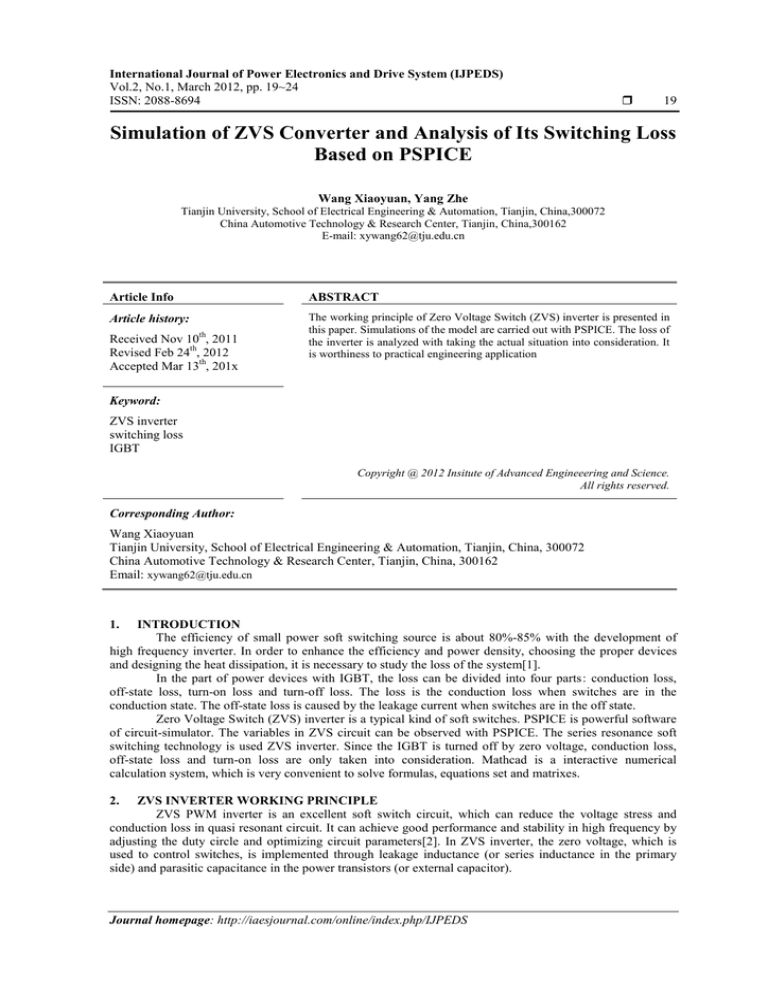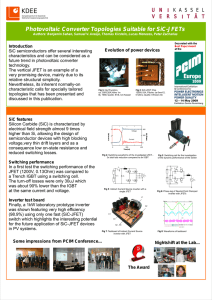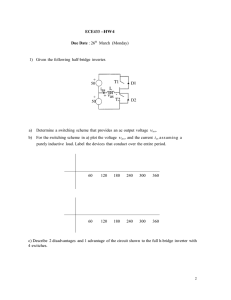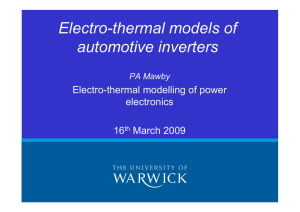
International Journal of Power Electronics and Drive System (IJPEDS)
Vol.2, No.1, March 2012, pp. 19~24
ISSN: 2088-8694
19
Simulation of ZVS Converter and Analysis of Its Switching Loss
Based on PSPICE
Wang Xiaoyuan, Yang Zhe
Tianjin University, School of Electrical Engineering & Automation, Tianjin, China,300072
China Automotive Technology & Research Center, Tianjin, China,300162
E-mail: xywang62@tju.edu.cn
Article Info
ABSTRACT
Article history:
th
Received Nov 10 , 2011
Revised Feb 24th, 2012
Accepted Mar 13th, 201x
The working principle of Zero Voltage Switch (ZVS) inverter is presented in
this paper. Simulations of the model are carried out with PSPICE. The loss of
the inverter is analyzed with taking the actual situation into consideration. It
is worthiness to practical engineering application
Keyword:
ZVS inverter
switching loss
IGBT
Copyright @ 2012 Insitute of Advanced Engineeering and Science.
All rights reserved.
Corresponding Author:
Wang Xiaoyuan
Tianjin University, School of Electrical Engineering & Automation, Tianjin, China, 300072
China Automotive Technology & Research Center, Tianjin, China, 300162
Email: xywang62@tju.edu.cn
1.
INTRODUCTION
The efficiency of small power soft switching source is about 80%-85% with the development of
high frequency inverter. In order to enhance the efficiency and power density, choosing the proper devices
and designing the heat dissipation, it is necessary to study the loss of the system[1].
In the part of power devices with IGBT, the loss can be divided into four parts: conduction loss,
off-state loss, turn-on loss and turn-off loss. The loss is the conduction loss when switches are in the
conduction state. The off-state loss is caused by the leakage current when switches are in the off state.
Zero Voltage Switch (ZVS) inverter is a typical kind of soft switches. PSPICE is powerful software
of circuit-simulator. The variables in ZVS circuit can be observed with PSPICE. The series resonance soft
switching technology is used ZVS inverter. Since the IGBT is turned off by zero voltage, conduction loss,
off-state loss and turn-on loss are only taken into consideration. Mathcad is a interactive numerical
calculation system, which is very convenient to solve formulas, equations set and matrixes.
2.
ZVS INVERTER WORKING PRINCIPLE
ZVS PWM inverter is an excellent soft switch circuit, which can reduce the voltage stress and
conduction loss in quasi resonant circuit. It can achieve good performance and stability in high frequency by
adjusting the duty circle and optimizing circuit parameters[2]. In ZVS inverter, the zero voltage, which is
used to control switches, is implemented through leakage inductance (or series inductance in the primary
side) and parasitic capacitance in the power transistors (or external capacitor).
Journal homepage: http://iaesjournal.com/online/index.php/IJPEDS
20
ISSN: 2088-8694
The circuit diagram is shown in Fig. 1. D1~D4 are the internal parasitic diodes of Q1~Q4. C1~C4
are the parasitic capacitances. Lr is the resonance inductor which includes the leakage inductor of the
transformer. The two power transistors in each leg are conducted 180 degrees complementary. The output
voltage can be adjusted by change the phase-shift within conducting two legs. The leg with Q1 and Q3 are
the leading-leg. The another with Q2 and Q4 is the lagging-leg. The former has a leading angle. When the Lf
is big enough, the filter inductor can be taken as a constant current source which value is equal to the load
current. R is the load and Cf is the filter capacitor.
Fig. 1 Circuit diagram of ZVS inverter
Fig. 2 Main waveform of the circuit simulation
The simulation waveform in circuit is shown in Fig. 2. Q1 is turned off when time is t0. The
primary current transfers from Q1 to the branch of C3 and C1 in the period of t0—t1. C3 is discharged when
C1 is charged. Q1 is the zero-voltage turn-off under the influence of C1 and C3. The voltage of C3 drops to
zero when time is t1. At the same time, D3 and Q3 are turned on. Q3 is zero-voltage turn-on. The primary
current flows from the D3. There is no current in Q3[3].
3. RESULTS AND ANALYSIS
3.1. Simulation of the ZVS inverter with PSPICE
In order to verify work principle of the ZVS inverter and make the analysis of inverter losses
convenient, the inverter circuit is simulated and analyzed with PSPICE. Simulation model is shown as Fig. 3.
Main data used in the simulation are as following:
Input DC voltage: 48V
Output DC voltage: 22V
Output Current: 2.75A
Filter inductance: 60µH
Resonant inductor: 2.7µH Filter capacitor: 10µF
Resonant capacitor: 650pF switching frequency: 1MHz
The simulation waveform is shown in Fig.4. This is the stable waveform. When switch S1 is turn
off, the resonant capacitor limits its voltage rate of rise. The zero-voltage turn-off of Q1 is achieved[5]. When
the resonant capacitor voltage is declined to zero, the anti-parallel diode of S1 is turn on. The voltage of Q1 is
limited to zero. The opening of S1 is zero-voltage too. The different output voltage is get by changing the
duty cycle.
The simulation waveform of ZVS inverter power is shown in Figure 5. The blue line is output
power, and the red and yellow one are output power of the two switch tube. As the switching frequency is
1MHz, the cycle is 1µs. It is helpful for loss calculation to analyze the two switching tube efficiency.
As the switching speed of diode is slower than switching tube, most of the inverter switching loss is
the tube switching loss. The main reason for the switch loss is the positive and reverse recovery process of
diode. The diode which has better recovery performance is chosen generally to reduce the switch loss, such
as schottky diodes.
IJPEDS Vol. 2, No. 2, March 2012 : 19 – 24
IJPEDS
ISSN: 2088-8694
C1
U/V
2.5
650pf
21
V(V2:+)
0
D1
L1
1
L2
2
1
2.7uH
Dbreak
2
U/V
60uH
2.5
V (V3:+)
0
D2
U/V
V(R1:2)
+
-
+
-
S1
+
-
S2
Dbreak
V1
18.38
R1
C2
+
-
Sbreak
Sbreak
D3
Dbreak
48Vdc
8
10uf
18.36
U/V
V(S1:3,S1:4)
0
0
-200
I/A
V3
V2
I(S1:3)
0
172.854
173.600
174.000
174.400
174.800
Fig. 4 Simulation waveform of ZVS inverter
Fig. 3 The simulation model of ZVS inverter
30
173.200
W(R1)
20
10
V(V2)
W(S1)
W(S2)
0
-10
71.200
71.600
72.000
72.400
72.800
Fig. 5 Power simulation waveform
3.2. Calculations of IGBT losses with Mathcad
In order to study the inverter losses, it is necessary to calculate the losses of IGBT with Mathcad. It
has some reference value to choose appropriate IGBT and cooling system of inverter.The characteristics
curves of IGBT and diode are shown as Fig.6 and Fig.7. When junction temperature is higher, the forward
characteristic curve goes to left. The forward voltage drop gets smaller. The influence of temperature on the
parameters of devices is not discussed in this paper.
Fig. 6 Forward characteristic curve of IGBT
Fig. 7 Forward characteristic curve of diode
Title of manuscript is short and clear, implies research results (First Author)
22
ISSN: 2088-8694
FF300R17KE3 diode is selected. The junction temperature is set TVJ=125 . To make the calculated
losses value more accurately, the curves of Vce_igbt and Iigbt are obtained by using the software of GetData
Graph. The curve data is displayed in table 1.
Making the following assumptions before the losses of inverter is analyzed[6]:
not discuss the influence of leakage inductance and other parasitic parameters;
not discuss the influence of temperature on various parameters of the device;
ignoring the input voltage ripple and fluctuations.
The calculated formula of φb is followed like this:
I
0.000982⋅ π ⋅ f 0 ⋅
2
⋅ 180
φb =arctan
π
U
(1)
Table 1. The Curve Data of Vce_igbt and I igbt
Vce_igbt
2.401 712 857 1
2.055 715 714 2
1.749 839 230 4
1.439 294 021 1
1.284 920 342 1
1.012 948 274 2
0.923 910 384 8
0.837 849 321 3
0.593 802 313 4
I igbt
22.423 982 502
15.302 194 856
10.739 204 852
7.129 240 318 7
4.483 920 452 2
2.247 382 944 5
1.450 294 853 2
7.934 021 375 4
5.385 394 857 3
Fig. 8 Characteristic curve of power and voltage
Fig. 8 is the curve of output power. The curve is changed with the voltage. The table 2 can be get by
the software of GetData Graph.
Table 2 The Curve Data of Ude and P
Udc
500.000 000 00
550.138 294 74
603.886 086 34
645.573 854 52
698.362 137 85
753.459 024 21
802.472 598 46
909.345 728 20
923.568 294 23
942.648 294 37
974.428 476 20
993.472 804 38
995.382 749 24
1 039.847 524 65
P
859.443 865 89
942.845 930 28
103.895 478 24
110.028 942 09
117.149 227 83
122.608 490 32
125.109 285 74
121.938 572 93
101.302 983 01
942.049 282 93
739.102 732 13
428.492 109 34
298.209 378 00
106.392 845 03
Fig. 9 Figure of experiment equipment
IJPEDS Vol. 2, No. 2, March 2012 : 19 – 24
IJPEDS
ISSN: 2088-8694
23
The required parameters can be calculated through the appropriate formula. The formula (2) and (3)
are the loss formulas of IGBT and diode[7]. The relevant loss can be calculated and compared with the
parameters given by the mill. It is helpful to analyze the loss of ZVS inverter.
cos( φb )
1
Pigbt =
+ mb ⋅
⋅ Vce ⋅ I m
8
2 ⋅π
cos( φb )
1
2
+ + mb ⋅
⋅ R ⋅ (I )
3⋅π ce m
8
cos( φ b )
1
Pdiode =
− mb ⋅
V f I m
8
2π
cos( φ b )
1
2
+ − mb ⋅
R f (I m )
3
⋅
π
8
(2)
(3)
In the expression, mb is the model index for different points, and φb is the phase angl.
3.3. Experiment and analysis
The experiment equipment can be get on the basis of principium of inverter as in Fig.9. It is
controlled by PWM pattern. The controlled pulse is showed as Fig.10. There is dead-time in the Figure. In
order to avoid the H bridge to turn on at the same time, a guard period must be set. It can effectively avoid
the delay effect. The effect can cause that an arm of the bridge do not completely shut off. But another bridge
arm is in conducting state. The module cannot be damaged with the guard period. The output voltage is
showed as Fig. 11.
Fig.11 Output voltage
Fig.10 Trigger pulse
4.
Conclusion
In this paper, the main study point is the switching loss of inverter. It is apparent to get the voltage,
current and power waveforms with the software of Mathcad and PSPICE. It is helpful to understand the
working principle of ZVS. It is easy to get the power loss efficiency of switch and it is useful to analyze the
inverter loss, compared with the data given by the mill.
Acknowledgements
I am very grateful to my tutor Professor Wang for giving me guidance and help.
References
[1]
Hong Naigang, A new scheme for dispersed pulse modulation in DC link of the zero switching loss inverter.
Industrial Technology, 1996. (ICIT '96).
Title of manuscript is short and clear, implies research results (First Author)
24
[2]
[3]
[4]
[5]
[6]
[7]
ISSN: 2088-8694
Bryant, A.T. Roberts, G.J. Walker, A. Mawby, P.A. Fast Inverter Loss Simulation and Silicon Carbide Device
Evaluation for Hybrid Electric Vehicle Drives. Power Conversion Conference - Nagoya, 2007. PCC '07.
WANG Zhi-xia; JIA Yun-feng; ZHAO Wen-tao; HE Wen-ping; HUAN Gui-xian. Study of a New PWM SoftSingle-Switched Converter Without switching Stresses, Northeast China Institute of Electric Power Engineering.
2003(6).
Itoh, J.-i. Ogura, T. Evaluation of total loss for an inverter and motor by applying modulation strategies. Power
Electronics and Motion Control Conference (EPE/PEMC), 2010 14th International.
Jordan, J. Esteve, V. Dede, E. Magraner, J.M. Automated Calculation Method to Determine the Output Power
Based on the Frequency for Induction Heating IGBT Parallel Inverter. Power Electronics Specialists Conference,
2007. PESC 2007. IEEE.
Jung-Goo Cho, Ju-Won Back, Chang-Yang Jeong, et al. Novel Zero-Voltage and Zero-Current Switching Full
Bridge PWM Converter using Tranformer Auxiliary Winding .IEEE Transactions on Power Electronics, 2000,15,
15 (2) :250-257.
Chien-Ming Wang; Ching-Hung Su; Chien-Yeh Ho; Kuo-Lun Fang .A Novel ZVS-PWM Single-Phase Inverter
Using a Voltage Clamp ZVS Boost DC Link [J]. IEEE Transactions on Industry Applications, 1997,5( 33) :309 .
Bibliography of authors
Wang Xiaoyuan ( 1962 -), Professor, doctoral tutor. Mainly research direction is design and control of
the motor elements. xywang62@tju.edu.cn
Yang zhe,(1987-),master. graduated from the China University of Petroleum in 2009 as a
double bachelor: Electrical and English.
IJPEDS Vol. 2, No. 2, March 2012 : 19 – 24






